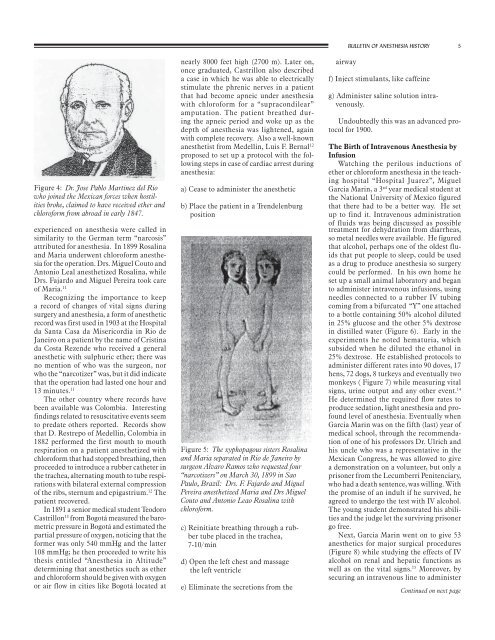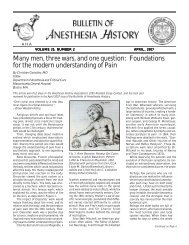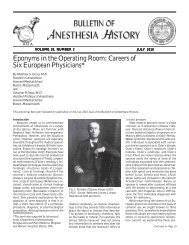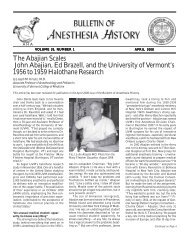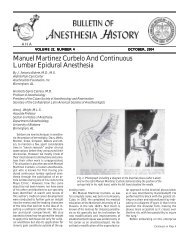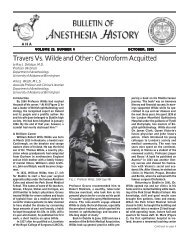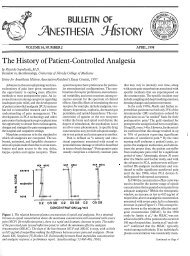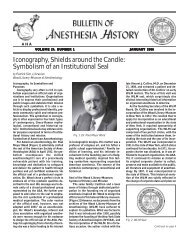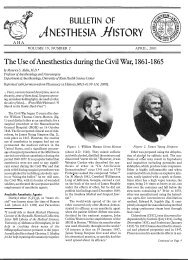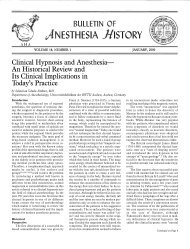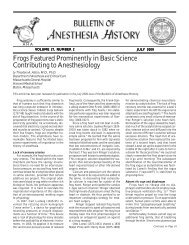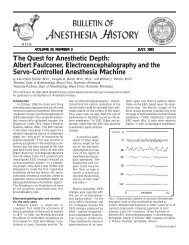Original Contributions of Latin-Ameri- cans to Anesthesia
Original Contributions of Latin-Ameri- cans to Anesthesia
Original Contributions of Latin-Ameri- cans to Anesthesia
Create successful ePaper yourself
Turn your PDF publications into a flip-book with our unique Google optimized e-Paper software.
Figure 4: Dr. Jose Pablo Martinez del Rio<br />
who joined the Mexican forces when hostilities<br />
broke, claimed <strong>to</strong> have received ether and<br />
chlor<strong>of</strong>orm from abroad in early 1847.<br />
experienced on anesthesia were called in<br />
similarity <strong>to</strong> the German term “narcosis”<br />
attributed for anesthesia. In 1899 Rosalina<br />
and Maria underwent chlor<strong>of</strong>orm anesthesia<br />
for the operation. Drs. Miguel Cou<strong>to</strong> and<br />
An<strong>to</strong>nio Leal anesthetized Rosalina, while<br />
Drs. Fajardo and Miguel Pereira <strong>to</strong>ok care<br />
<strong>of</strong> Maria. 11<br />
Recognizing the importance <strong>to</strong> keep<br />
a record <strong>of</strong> changes <strong>of</strong> vital signs during<br />
surgery and anesthesia, a form <strong>of</strong> anesthetic<br />
record was first used in 1903 at the Hospital<br />
da Santa Casa da Misericordia in Rio de<br />
Janeiro on a patient by the name <strong>of</strong> Cristina<br />
da Costa Rezende who received a general<br />
anesthetic with sulphuric ether; there was<br />
no mention <strong>of</strong> who was the surgeon, nor<br />
who the “narcotizer” was, but it did indicate<br />
that the operation had lasted one hour and<br />
13 minutes. 11<br />
The other country where records have<br />
been available was Colombia. Interesting<br />
findings related <strong>to</strong> resuscitative events seem<br />
<strong>to</strong> predate others reported. Records show<br />
that D. Restrepo <strong>of</strong> Medellin, Colombia in<br />
1882 performed the first mouth <strong>to</strong> mouth<br />
respiration on a patient anesthetized with<br />
chlor<strong>of</strong>orm that had s<strong>to</strong>pped breathing, then<br />
proceeded <strong>to</strong> introduce a rubber catheter in<br />
the trachea, alternating mouth <strong>to</strong> tube respirations<br />
with bilateral external compression<br />
<strong>of</strong> the ribs, sternum and epigastrium. 12 The<br />
patient recovered.<br />
In 1891 a senior medical student Teodoro<br />
Castrillon 13 from Bogotá measured the barometric<br />
pressure in Bogotá and estimated the<br />
partial pressure <strong>of</strong> oxygen, noticing that the<br />
former was only 540 mmHg and the latter<br />
108 mmHg; he then proceeded <strong>to</strong> write his<br />
thesis entitled “<strong>Anesthesia</strong> in Altitude”<br />
determining that anesthetics such as ether<br />
and chlor<strong>of</strong>orm should be given with oxygen<br />
or air flow in cities like Bogotá located at<br />
nearly 8000 feet high (2700 m). Later on,<br />
once graduated, Castrillon also described<br />
a case in which he was able <strong>to</strong> electrically<br />
stimulate the phrenic nerves in a patient<br />
that had become apneic under anesthesia<br />
with chlor<strong>of</strong>orm for a “supracondilear”<br />
amputation. The patient breathed during<br />
the apneic period and woke up as the<br />
depth <strong>of</strong> anesthesia was lightened, again<br />
with complete recovery. Also a well-known<br />
anesthetist from Medellin, Luis F. Bernal 12<br />
proposed <strong>to</strong> set up a pro<strong>to</strong>col with the following<br />
steps in case <strong>of</strong> cardiac arrest during<br />
anesthesia:<br />
a) Cease <strong>to</strong> administer the anesthetic<br />
b) Place the patient in a Trendelenburg<br />
position<br />
Figure 5: The xyphopagous sisters Rosalina<br />
and Maria separated in Rio de Janeiro by<br />
surgeon Alvaro Ramos who requested four<br />
“narcotizers” on March 30, 1899 in Sao<br />
Paulo, Brazil: Drs. F. Fajardo and Miguel<br />
Pereira anesthetized Maria and Drs Miguel<br />
Cou<strong>to</strong> and An<strong>to</strong>nio Leao Rosalina with<br />
chlor<strong>of</strong>orm.<br />
c) Reinitiate breathing through a rubber<br />
tube placed in the trachea,<br />
7-10/min<br />
d) Open the left chest and massage<br />
the left ventricle<br />
e) Eliminate the secretions from the<br />
airway<br />
BULLETIN OF ANESTHESIA HISTORY 5<br />
f) Inject stimulants, like caffeine<br />
g) Administer saline solution intravenously.<br />
Undoubtedly this was an advanced pro<strong>to</strong>col<br />
for 1900.<br />
The Birth <strong>of</strong> Intravenous <strong>Anesthesia</strong> by<br />
Infusion<br />
Watching the perilous inductions <strong>of</strong><br />
ether or chlor<strong>of</strong>orm anesthesia in the teaching<br />
hospital “Hospital Juarez”, Miguel<br />
Garcia Marin, a 3 rd year medical student at<br />
the National University <strong>of</strong> Mexico figured<br />
that there had <strong>to</strong> be a better way. He set<br />
up <strong>to</strong> find it. Intravenous administration<br />
<strong>of</strong> fluids was being discussed as possible<br />
treatment for dehydration from diarrheas,<br />
so metal needles were available. He figured<br />
that alcohol, perhaps one <strong>of</strong> the oldest fluids<br />
that put people <strong>to</strong> sleep, could be used<br />
as a drug <strong>to</strong> produce anesthesia so surgery<br />
could be performed. In his own home he<br />
set up a small animal labora<strong>to</strong>ry and began<br />
<strong>to</strong> administer intravenous infusions, using<br />
needles connected <strong>to</strong> a rubber IV tubing<br />
coming from a bifurcated “Y” one attached<br />
<strong>to</strong> a bottle containing 50% alcohol diluted<br />
in 25% glucose and the other 5% dextrose<br />
in distilled water (Figure 6). Early in the<br />
experiments he noted hematuria, which<br />
subsided when he diluted the ethanol in<br />
25% dextrose. He established pro<strong>to</strong>cols <strong>to</strong><br />
administer different rates in<strong>to</strong> 90 doves, 17<br />
hens, 72 dogs, 8 turkeys and eventually two<br />
monkeys ( Figure 7) while measuring vital<br />
signs, urine output and any other event. 14<br />
He determined the required flow rates <strong>to</strong><br />
produce sedation, light anesthesia and pr<strong>of</strong>ound<br />
level <strong>of</strong> anesthesia. Eventually when<br />
Garcia Marin was on the fifth (last) year <strong>of</strong><br />
medical school, through the recommendation<br />
<strong>of</strong> one <strong>of</strong> his pr<strong>of</strong>essors Dr. Ulrich and<br />
his uncle who was a representative in the<br />
Mexican Congress, he was allowed <strong>to</strong> give<br />
a demonstration on a volunteer, but only a<br />
prisoner from the Lecumberri Penitenciary,<br />
who had a death sentence, was willing. With<br />
the promise <strong>of</strong> an indult if he survived, he<br />
agreed <strong>to</strong> undergo the test with IV alcohol.<br />
The young student demonstrated his abilities<br />
and the judge let the surviving prisoner<br />
go free.<br />
Next, Garcia Marin went on <strong>to</strong> give 53<br />
anesthetics for major surgical procedures<br />
(Figure 8) while studying the effects <strong>of</strong> IV<br />
alcohol on renal and hepatic functions as<br />
well as on the vital signs. 15 Moreover, by<br />
securing an intravenous line <strong>to</strong> administer<br />
Continued on next page


